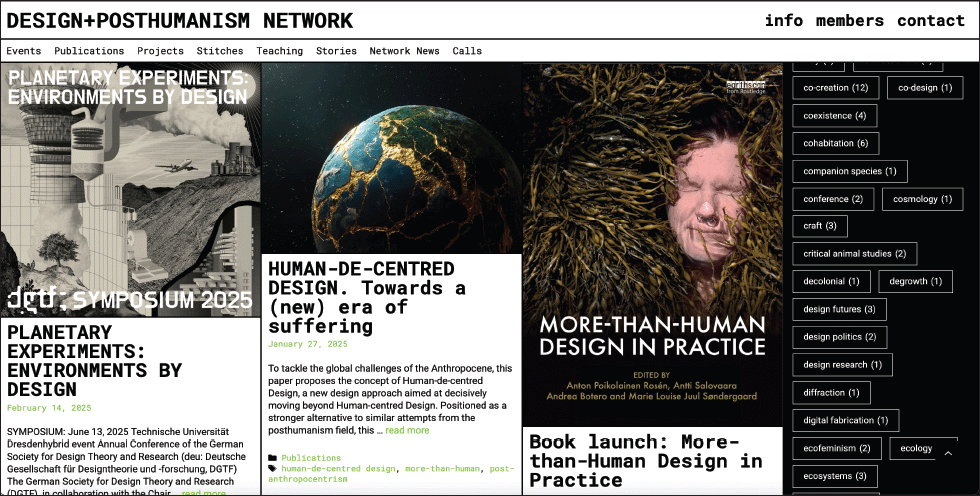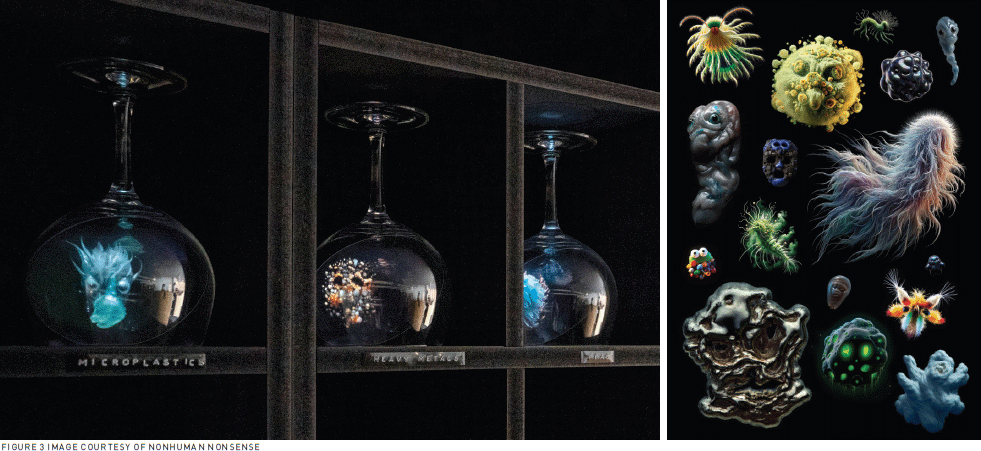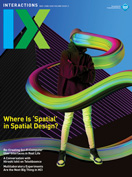Authors:
Johanna Mehl, Sven Quadflieg, Satu Samira Hamed, Sebastian Gatz
The Design+Posthumanism Network was created by Swedish designers in 2018 and has since grown into an international, interdisciplinary exchange platform and a living archive. The network includes artists, educators, entrepreneurs, and scholars who critically interrogate the biases embedded in design, its entanglements with anthropocentric worldviews, and its complicity in reproducing structures of power. Bridging design practice, scholarship, education, and activism—domains that frequently blur into one another—we are united by a commitment to more-than-human coexistence that includes animals, plants, and all that exists in between and beyond. This article proposes that the network itself functions as a critical practice that is scaling more-than-human design by sustaining and propagating the conversation about how design metabolizes in contact with posthumanist thought and, conversely, how designerly and artistic approaches can inform critical posthumanism and its related discourses.
→ Design practice can literalize, verbalize, and materialize posthumanist critiques of the conditions of our time in both form and content.
→ The Design+Posthumanism Network invites contributions to its growing archive that features examples of what the intersection of critical posthumanism and design can look like.
Critical posthumanist theory is, at its core, an exploration of networks, intersections, intra-actions, crossings, cat's cradles, rhizomes, webs, transcorporeal entanglements, and root systems (see sidebar on page 69). If posthumanism resists the world's insistence on binaries and boundaries, then the network might be its most fitting metaphor—an emblem of fluidity, hybridity, motion, and connection. Posthumanism challenges the boundaries that have structured Western consciousness—human and more than human, nature and culture, mind and body—and acknowledges that all beings exist within complex networks of agency, power, responsibility, and care.
 Putting Conceptual and Material Webs into Practice
Putting Conceptual and Material Webs into Practice
Donna Haraway's notion of "making-with," or sympoiesis—the idea that "nothing makes itself; nothing is really autopoietic or self-organizing"—offers vocabulary to unearth the relational nature of design and designing [1]. Design is a world-making discipline—both deliberate and unconscious in its effects, as it is inextricably linked to the person who designs, the materials used, and the disciplinary logics applied. Design processes, tools, and designed things do not simply exist "out there"; they world—in the sense that they contribute to shaping and structuring what we perceive to be true about the world. Recognizing that worlding is never an individual act, but always a worlding-with, in company of people, things, and thoughts, triggers questions that embody what Haraway calls the response-ability of making-with: Which notions of "normal" or "accepted" human embodiment does this work assume? Whose subjectivity is centered? How does my design work assume or reinforce human centrality? Where do the materials in my design come from and what histories of extraction, labor, and violence do they carry? What kind of world does my design contribute to shaping? Does my work reproduce colonial, patriarchal, or capitalist logics, even unintentionally?
 Quilting More-Than-Human Design
Quilting More-Than-Human Design
While the network foregrounds design that engages these kinds of questions, it first and foremost tries to cultivate connections among a network of people. Its fundamental purpose is to render unthinkable solitary design—that is, isolated from histories, materialities, sites of extraction, systems of power—advocating for an awareness of the peoples and cultures that continuously shape it. In this spirit, the recently established network board seeks to actively facilitate occasions for collective thinking, working, publishing, and teaching. The network's key tool is its website (designandposthumanism.org), a resource and living archive of member activities and a growing database where each member articulates how their work connects to the concepts of posthumanism (Figure 1).
 | Figure 1. A screenshot of Design+Posthumanism Network's website. |
The platform naturally draws in explorations of all things fluid, malleable, leaky, organic, and speculative in and about design, while discussing subversive ways of designing and critically engaging with technologies that increasingly shape the field in both subtle and profound ways. More-than-human agencies of animals, plants, bacteria, cyborgs, water, and stone are frequently negotiated. It is a space for tracing human-environment relations as they glide across scales, from the microscopic to the infrastructural, always illuminating the relations that bind them. Featured projects, which are are both practical and theoretical, institutional and noninstitutional, seek out linkages to critical schools of thought that interrogate entanglements of the built environment with structures of power, such as critical race theory, feminist science, and technology studies.
The website collects these activities in a grid-like, blog-like structure that is constantly growing and reassembling. The "+" has become the programmatic glyph to signify the network and its activities, undergirded by Haraway's conclusion that "nothing is connected to everything; everything is connected to something" [1]. Between the grid and within the conceptual equations, we hope that an idea about what happens when design and posthumanism intersect emerges, without limiting what that might look like.
At the time of writing this article, the website archived 33 events, 25 publications, and 29 design projects. It hosts teaching resources, syllabi, and learning opportunities, and serves as a forum for sharing calls and collaborations. Among its many features is an evolving interview series we call Stitches: a micro-conversation format where a network member interviews another who then becomes the next interviewer, threading a continuous dialogue through the fabric of our collective.
While these categories overlap and blur into one another, they offer a way to navigate the members' endeavors, which can be used as resources and inspiration. You can zoom in on interaction design projects, such as Metamorphonic by Yuta Ikeya, an exploration and reimagination of interspecies' cocreation processes beyond exploitative structures. Domesticated silk moths (Bombyx mori), long integral to Japanese sericulture and revered as sacred, are bred and exploited for silk production with little attention to the worms' well-being. The project offers a counter-design through three environments where the moth completes its life cycle on its own terms. Capacitive sensors detect their movements to create synthesizer-generated tones, an ambient echo of the moths' presence (Figure 2).
 | Figure 2. Metamorphonic is an exploration of an alternative relationship between humans and silkworms. |
Metamorphonic exemplifies how projects under the umbrella of design and posthumanism challenge the tacit anthropocentric "right to access the bodies of all other living entities" [2] and treating "matter as passive stuff" [3]. Design, when understood as a collection of practices that emerged in response to industrialization in the West, has historically reinforced human dominance over the material world, often treating nature as a passive resource to be shaped, extracted, and controlled.
Metamorphonic resists a utilitarian relationship to more-than-humans while simultaneously confronting the uneasy reality that a truly mutualistic design practice remains unattainable. As a network of scholars and practitioners, we acknowledge that it will never be possible to truly step out of the human perspective when designing. The goal with employing a posthumanist perspective is not to erase uneasy design histories or deny the limits of our human vantage point, but to draw consequences from it without fortifying the West as the sole locus of design's pasts, presents, and futures. The understanding of design—as an inherently human-centered, industrial, and capitalist endeavor—is crumbling on many fronts, challenged by ecological crises, posthumanist thought, and the recognition of design's entanglement with more-than-human worlds.
This is visible, for example, in interaction design projects that try to reimagine technologies beyond imaginaries of "progress." Haunted Waters by Nonhuman Nonsense is an installation that makes the stories contained in water samples from all around the world visible. Their chemical formulas reveal histories of "struggles, accidents, wars, greed, and action." Portrayed as eerie beings, these traces of the technological mediation of our lives suggest that we are cyborgs, not human-machine hybrids trying to escape death or gain superstrength, but rather beings already enmeshed with the industrial forces of our time through microplastics, heavy metals, and PFAS. Contrary to transhumanism—that is, the designs surrounding a techno-ableist vision of overcoming the boundaries of a body rendered insufficient, inadequate, or obsolete, as well as the vision of a life transcended from the material realities of our worlds—a critical posthumanist perspective highlights our transcorporeal entanglements with them (Figure 4).
 | Figure 3. A growing collection of contaminated waters from around the world (left); visualizations "ghostifications" of the contaminants (right). |
 Bringing Design and Posthumanism Together
Bringing Design and Posthumanism Together
We seek to mobilize design as a means of exposing how systems of power work, especially when it comes to those that shape our idea of what it means to be human. Throughout the 19th and 20th centuries, designers have consistently sought to model the world around "the human" and its needs, thereby shaping and solidifying an idea of what it means to be human in the process. Many projects have attempted to derive design principles for the built environment by standardizing the human body. Notable examples include Le Corbusier's Modulor, an idealized proportional model based on the average male body, and Henry Dreyfuss' The Measure of Man and Woman, which documented the dimensions of standardized bodies to guide ergonomic design. These efforts reflect what Rosi Braidotti describes as the construction of "the human" as an abstract, idealized figure—one rooted in 18th- and 19th-century interpretations of classical antiquity and Renaissance ideals [4]. This figure consolidates the political, cultural, social, and technological hegemonies of the 20th century. Humanity, Braidotti notes, is depicted as overwhelmingly male, white, European, able-bodied, and heteronormative. Design perpetuates and encodes this normalized vision of humanity—sometimes visibly, at other times almost imperceptibly.
Design is often understood as solely intentional, meaning a design object, space, or process is made to nudge user behaviors in intentional ways. Yet, design carries cultural codes and assumptions that come into play long before the design process even begins. The fuzzy boundaries of the human are profoundly negotiated by critical theory, yet this figure is still frozen, sharply contoured, and stiffly embedded in infrastructures, domestic spaces, neighborhoods, and cities. It is a hidden presence in the material world and in habitual gestures, mundane objects, and interactions.
All of this is particularly difficult to navigate within the broader tension between political engagement and economic viability. Design as a discipline and profession is often caught between service-oriented industry and the imperatives of degrowth. A critical perspective in design often demands the dislodging of the very structures that sustain the parts of it that keep people financially afloat. What do we do when we literally can't afford to be critical? This is a particularly important question for those members of our network who do not work in academia or nongovernmental organizations, but in offices, agencies, or companies. A shift from human-centricity to a more-than-human perspective in the business context is not a seamless transition and requires thorough exploration.
Critical posthumanism stands in direct opposition to the dominant logics of efficiency, optimization, economic growth, and profit at the expense of ecological and social well-being. Its relevance to business lies in its potential to transform structures of labor and the lived realities that emerge from them. At best, critical posthumanism and its related concepts and critical theories trigger policy changes, which in turn reshape business practices—whether through a redefinition of labor that centers worker justice and extends to more-than-human contributors or through the legal recognition of more-than-human stakeholders in decision-making processes. While businesses have the capacity to drive meaningful innovation and foster regenerative practices that benefit both marginalized human communities and more-than-human entities, they must do so without falling into the trap of corporate sustainability rhetoric or greenwashing. The question is not how posthumanism can serve business as usual, but how it might normalize "unusual" business practices.
Lastly, we hope to contribute to this shift in consciousness—toward making solitary design unthinkable—through the development of an open source database, beginning with a collectively curated collection of literature on design and posthumanism. We invite you to contribute to this project and join the Design+Posthumanism Network, sharing your perspective and featuring your work on the website. Through collective engagement, we hope to grow a community that continues to challenge, expand, and reimagine the role of design in a more-than-human world.
1. Haraway, D.J. Staying with the Trouble: Making Kin in the Chthulucene. Duke University Press, 2016.
2. Braidotti, R. The critical posthumanities; or, is medianatures to naturecultures as zoe is to bios? Cultural Politics 12, 3 (2016).
3. Bennett, J. Vibrant Matter: A Political Ecology of Things. Duke University Press, 2010.
4. Braidotti, R. The Posthuman. Polity Press, 2013.
5. Barad, K. Meeting the Universe Halfway: Quantum Physics and the Entanglement of Matter and Meaning. Duke University Press, 2007.
6. Deleuze, G. and Guattari, F. A Thousand Plateaus: Capitalism and Schizophrenia. University of Minnesota Press, 1987.
7. Alaimo, S. Bodily Natures: Science, Environment, and the Material Self. Indiana University Press, 2010.
8. Tsing, A.L. The Mushroom at the End of the World: On the Possibility of Life in Capitalist Ruins. Princeton University Press, 2015.
Johanna Mehl is a fellow and doctoral candidate in cultural studies at the Chair of Digital Cultures TU Dresden. As a scholar, designer, and educator she is interested in design as a knowledge culture and its entanglements with environmental history, cybernetics, systems theory, and media theory. [email protected]
Sven Quadflieg is a professor of design at the Hamm-Lippstadt University of Applied Sciences. He holds a Ph.D. in design theory and a diploma in communication design. [email protected]
Satu Samira Hamed is founder of Planet Diplomats. She is also chair of Sustinaires ry, an association promoting sustainable digital development, and a board member of the Design+Posthumanism Network. [email protected]
Sebastian Gatz is an architect, artist, and auto mechanic working at the intersection of art, architecture, and technology. His research employs fictocritical and posthuman methods to investigate relationships between humans, nature, and technology. His interests include experimental metaphysics, degrowth practices, and digital fabrication. [email protected]
Intra-action: The mutual constitution of entangled agencies, challenging the notion of individual entities preexisting their interactions. Used by Karen Barad [5].
Cat's cradle: A metaphor for interwoven relationships and cocreation, emphasizing the entanglements between human and nonhuman actors in multispecies worlds. Used by Donna Haraway [1].
Rhizome: A hierarchical, decentralized model of knowledge, identity, and organization, where connections and multiplicities form in unpredictable ways. Used by Gilles Deleuze and Félix Guattari [6].
Transcorporealities: The porous and interconnected nature of bodies and environments, emphasizing material exchanges and ecological entanglements. Used by Stacy Alaimo [7].
Root systems: Underground networks of fungi and plants as metaphors for collaborative survival, interconnection, and resilience in precarious ecological and economic conditions. Used by Anna Tsing [8].
 Licensed under Creative Commons Attribution-NonCommercial-NoDerivs International 4.0.
Licensed under Creative Commons Attribution-NonCommercial-NoDerivs International 4.0.
The Digital Library is published by the Association for Computing Machinery. Copyright © 2025 ACM, Inc.






Post Comment
No Comments Found